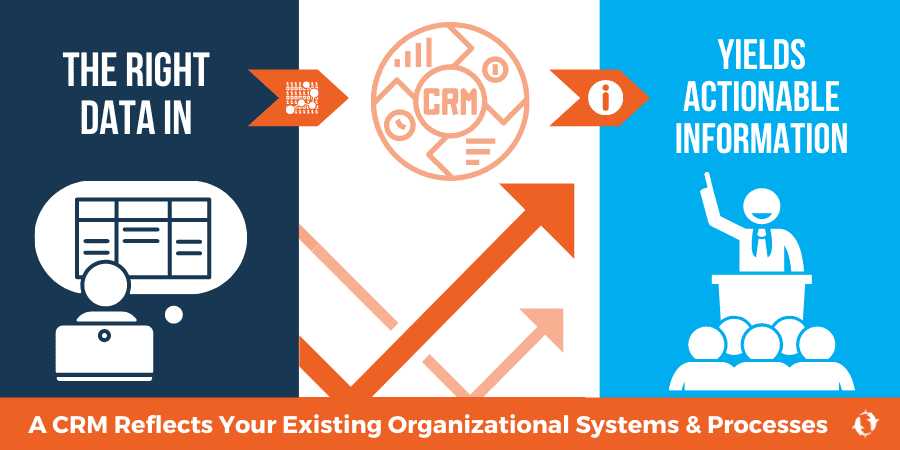
Migrating Customer Relationship Management Platforms, like Salesforce and HubSpot CRM, can be a successful way to springboard your teams towards sales success. But the move can also spell disaster if the right components are not present in your organization first. Let's take a look at specific reasons you may not need a new CRM.
A CRM Tool is a Reflection
Any CRM tool, whether that be HubSpot's Sales Hub CRM, SalesForce CRM, Oracle NetSuite's CRM, or any other CRM, is merely a reflection of the systems and process you have already established as an organization.
A CRM is a great central location to store data - but do you know what the right data to be storing to improve each department's decision making and strategies are?
Likewise, a CRM is a great tool for automating certain tasks and outreach efforts - but do the manual tasks and outreach effort underway right now contribute positively to your objectives?
A CRM is also only as good as the people who use it; good data in equals good information out. Inaccurate information, or incomplete data entry, distorts and compromises the information coming out. Always consider the human element of a successful versus failed CRM implementation.
You cannot purchase a CRM and expect it to solve your business problems without accounting for the time and investment required to set up the organizational systems and processes required for the CRM to accurately reflect in digital form what is actively taking place.

How to Know When a New CRM Isn’t the Answer
- Your organization already has cross-departmental transparency about prospect, customer, and partner interactions.
- You can already track target audience engagement, prospect conversions, deal progression, and clear results of your campaigns.
- Managers and directors already have enough data about user engagement across content and promotional platforms so they can measure ROI.
- Managers have visibility into direct sales interactions to understand what deals are being won and why versus what deals are being lost and why.
- Your direct sales team already keeps up-to-date interaction notes and follow-up tasks in a centralized location.
- Your direct sales team can already view historic trends and confidently forecast future sales.
- Your direct sales reps never forget to follow-up with their book of business to share information about product enhancements and purchase incentives.
- Training new employees is a breeze. Your tenured employees can pass information to new employees seamlessly, without having to spend weeks of only on-to-one time training on customer rolodexes, the ins and outs of product promotions, and hope the trainee takes good notes.
- Onboarding new partners and clients is a breeze.
- Your marketing team never complains about not having enough information, resources or tools to get their job done.
- Your team spends less time managing an onslaught of “can you update me on the status of X” emails and more time delivering innovative solutions together.
- Your teams can update contact information and view important documents while they are conducting business on the go, during business travel, and during trade shows and association events.
- It is rare that there is a miscommunication between your sales team and your marketing team.
- It is rare that there is a miscommunication between your service team and your sales team.
- You already have refined segments of contacts to nurture via manual and automated email marketing campaigns based on geography, demographics, problem to be solved, budget, and timeline.
- You can generate a precise report from your swaths of contact data in a matter of minutes with minimal headaches reformatting data in a spreadsheet.
- Your current solutions will not become outdated within the next couple of years.
- Your current solutions already integrate seamlessly with project management, relationship management, enterprise resource planning, customer service, marketing tools, billing, and other such business operations systems.
- Your customer service teams, marketing teams, and sales teams all have the same visibility into customer interactions, order history, order status, and prior customer service tickets.
- From the top down your teams feel like there is a place for everything and a thing for every place in their workflow, creation, outreach, and reporting efforts.
If these elements are the case, you'd likely be better off optimizing the current CRM system or refining certain aspects of your sales process to achieve even better results.
Steps to Take Before Moving CRM Platforms
- Listen to team members
- Define your strategy
- Define your process
- Determine if your organizational problems are a symptom of a lack of tools, a lack of process, or a lack of adoption
- Define a list of CRM needs versus CRM wants
- Identify which CRM system will be best for your organization
- Communicate expectations of team members for use of the CRM
- Form (and possibly incentivize) a Beta group within your organization to start with the new CRM, systems, and processes to work out the kinks before a full organizational roll-out
- Think about the short and long-term impacts, benefits, and potential risks
- Balance your team's workload to account for any temporary increase in inefficiencies during the transition period
- Get your documentation and existing data in order
- Consider and plan for contingencies in you implementation process such as a longer time frame than you expect
- Provide in-depth training for team members to ensure adoption and understanding
- Establish accountability to maintain your data, systems, processes, and tools
Get a HubSpot CRM Demo
At the pace businesses and industries are changing, there’s no time to fail. You may have underlying systems and organizational adoption issues that need to be addressed before or during a CRM implementation project.
If your managers and their teams are grumbling about inefficiencies, a lack of structure, a lack of communication and transparency between departments, or similar challenges, consider your options. Now may be a good time to implement a CRM or switching CRMs or you may not benefit from switching CRMs given other circumstances in your organization that need resolved first.
Talk with a human about if a CRM migration or first time CRM implementation is the right move for your organization.
Ready to Dive In?
Work with our team of Business Process experts and watch us take manual clunky systems, tech stacks, and processes and turn them into tailored, intelligent workflows that deliver business outcomes.


